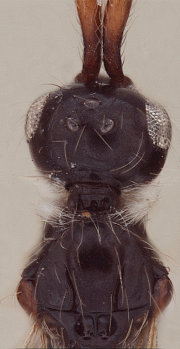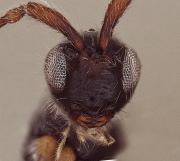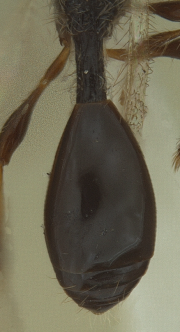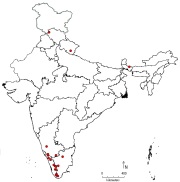 Fig 1. Female, profile |
 Fig 2. Head, dorsal view |
 Fig 3. Head, front view |
|
 Fig 4. Antenna (male) |
 Fig 5. Forewing |
 Fig 6. Mesosoma (male) |
 Fig 7. Distribution map |
|
Nomenclature
Spilomicrus Westwood, 1832: 129. Type Species: Spilomicrus stigmaticalis Westwood.
Loxotropa Förster, 1856: 122, 123, 126. Synonymized by Masner, 1964: 123-155.
Hoplopria Ashmead, 1893: 385, 386, 388. Synonymized by Masner and Garcia 2002.
Linkiola Kieffer, 1910b: 39. Synonymized by Masner and Garcia 2002.
Eriopria Kieffer, 1910a: 693, 744. Synonymized by Masner, 1964: 123-155.
Tritopria Kieffer, 1910a: 717, 748. Synonymized by Masner, 1964: 123-155.
Cologlyptus Crawford, 1910: 123. Synonymized by Masner, in Krombein and Burks, 1967: 285-305.
Scutellipria Szabó, 1961: 53-493. Synonymized by Masner, 1964: 123-155.
Diagnosis
Medium sized, around 1.5-3mm long. Head and body black to brownish black, with appendages lighter in colour. Body smooth and shining, lacking micropilosity, but with sparse long semierect hairs, never with foam-like structures. Rich hairy cushions on postgena, sides of pronotum and upper part of propleuron.
Head subglobular. Antennal shelf often well developed. Head smooth and shiny. Median frons without pits or transverse rugosities. Orbital carina absent. Mandibles normal, bidentate and not beak-like. Malar sulcus usually indicated. Temples longer than eye height. Antennae in both sexes 13-segmented. Apical rim of A1 ventrally excavate and produced into flaps. Female antennae with somewhat distinct but non-abrupt clava, 5, 6 or 7 segmented. A13 as long as A12. Male antenna filiform, segment 3 subequal to 4, A4 feebly modified, slightly emarginate. Pilosity on antennae short, not as long as width of A2.
Cervix smooth. Pronotal shoulders angulate. Mesoscutum with notauli variably indicated, complete or reduced to pits. Humeral sulcus distinct. Anterior scutellar pits bifoveate. Lateral and posterior scutellar pits sometimes present. Scutellar sheath broad, lower margin bordered by an inner row of fine longitudinal foveae. Sternaulus indicated. Metapleuron densely hairy. Dorsellum with three keels medially. Propodeum with median keel anteriorly raised into a spine, with a dorsal semi-hyaline zone. Nucha indicated in some cases.
Wings fully developed. Forewing venation extending to almost half of forewing length. Costal cell broad. Marginal vein short. Postmarginal vein not distinct, stigmal vein longer than marginal vein, slanting. A nebulous arcuate basal vein indicated at times. Disc of forewing often with a white hairless streak medially. Marginal cilia of forewings very much reduced, nearly one-eighth of forewing width. Hindwings with submarginal vein complete.
Petiole always longer than wide, usually with longitudinal striae. Anterior margin of T2/large tergite emerging far above level of petiole and without a median furrow, rarely with two hairy depressions anterolaterally.
Metasoma elongate basal tergites telescoped under large tergite.
Geographic Distribution
See Fig. 7 for distribution of the genus in India.
Species known from India
1. Spilomicrus anamalaiensis Sharma
2. Spilomicrus chinnarensis Rajmohana & Narendran
3. Spilomicrus eraviensis Rajmohana & Narendran
4. Spilomicrus keralensis Rajmohana & Narendran
5. Spilomicrus kumaonensis Sharma
6. Spilomicrus manii Rajmohana & Narendran
7. Spilomicrus parambiensis Rajmohana & Narendran
8. Spilomicrus poroensis Sharma
9. Spilomicrus siwalikensis Sharma
10. Spilomicrus yercaudensis Rajmohana & Narendran
Remarks
Commonly represented in collections. A widespread genus that can be diagnosed by the robust body, normal mandibles, 13-segmented antennae in both sexes, female antennae lacking an abrupt clava, distinct notauli, anterior scutellar, wings fully developed or even brachypterous, reduced marginal cilia and anterior margin of T2 without any concavity.
References
Ashmead, W. H. 1893. Monograph of the North American Proctotrypidae. United States National Museum Bulletin 45: 1-472.
Crawford, J.C. 1910. New Hymenoptera from the Philippine Islands. Proceedings of the United States National Museum, 38: 119-133.
Förster, A. 1856. Hymenopterologische Studien. II. Heft. Chalcidiae und Proctotrupii, 2: 1-152. Aachen: Ernsteer Meer.
Kieffer, J. J. 1910a. Beschreibung neuer suedamerikanischer im Zoologischen Museum zu Berlin aufbewahrter Diapriiden. Entomologische Rundschau, 27: 39-56.
Kieffer, J. J. 1910b. Species des Hyménoptères d'Europe et d'Algérie. Vol. 10. Pages 593-752. Librarie Scientifique A. Hermann & Fils, Paris. Pp.
Masner, L. 1964. A comparison of some Nearctic and Palearctic genera of Proctotrupoidea (Hymenoptera) with revisional notes. Cˇ asopis Cˇ eskoslovenske´ Spolecˇnosti Entomologicke,´ 61: 123-155.
Masner, L and Garcia, J.L. 2002. The genera of Diapriinae (Hymenoptera: Diapriidae) in the New World. Bulletin of the American Museum of Natural History, 268: 1-138.
Rajmohana, K and Bijoy, C., 2012. A checklist of Diapriidae and Proctotrupidae (Hymenoptera: Insecta) from India.
Szabó, J.B. 1961. Neue palaearktische Gattungen und Arten der Diapriiden in der Sammlung des Ungarischen Naturwissenschaftlichen Museums (Hymenoptera, Proctotrupoidea, Diapriidae). Annales Historico-Naturales Musei Nationalis Hungarici, 53: 491-494.
|